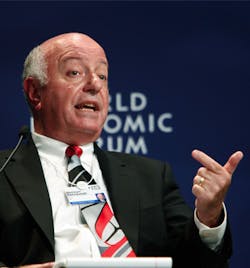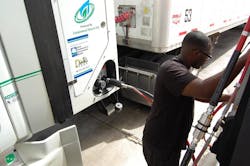Quite a year 2014 has been, not in the least due to all the attention that got paid to transportation both as an election issue and as a source of regulatory squabbling on Capitol Hill – with more regulatory conflagrations ahead for trucking in 2015.
More importantly, though, I think, will be the larger “macro-economic” picture not just for the U.S. but for the world as a whole. For if the U.S. economy keeps to its current path, without too much global disruption knocking it off balance, trucking could be poised to do quite well financially in 2015 – not in the least as what’s become a long-term driver shortage will keep putting constraints on available freight capacity.And freight volumes should grow in 2015, at least according to the “big picture” economic forecast issued earlier in December by Nariman Behravesh (at right), chief economist for global consulting firm IHS.
[FYI: Behravesh makes some pretty accurate economic predictions – you can see for yourself based on what he augured for 2014 by clicking here.]
“The global economy is expected to expand at a rate of 3% or slightly higher in 2015 after three years of global growth stuck in the 2.5% range,” he said in his forecast, with solid and improving growth in the U.S. and a slight pickup in the pace of Eurozone economic activity contribute to the moderately upbeat assessment, Behravesh noted. Other important “contributors” to economic growth in 2015 include much lower oil prices and more monetary stimulus—in particular, from the Bank of Japan (BoJ), the European Central Bank (ECB), and the People’s Bank of China (PBoC).
That fiscal activity will not only support growth, Behravesh stressed, but could also provide the basis for some upside surprises.
“Unfortunately, though, many of the downside risks that have plagued the global economy since the end of the Great Recession remain in place, including high public- and private-sector debt levels, corporate risk aversion, and daunting geopolitical risks,” he emphasized.
That’s worth keeping in mind as Behravesh lays out what he thinks will happen economically in 2015:
- The U.S. economy will continue to outperform other developed economies in 2015, with solid growth in the 2.5% to 3% range, on the strength of domestic demand.
- Strong U.S. jobs growth, improved household finances – the best since the early 2000s – and low gasoline prices will result in consumer spending growing at a rate of about 3% for the next two to three years; critical for growth as consumer spending accounts for nearly 70% of gross domestic product (GDP) activity.
- The Eurozone recovery will proceed at a sluggish pace, with the highlight of the region being robust U.K. growth. The Eurozone will experience a very modest acceleration of growth of 1.4%, even though significant problems, such as worrying labor markets, still persist.
- However; the UK economy will post solid growth in the 2.5% to 3% range in 2015.
- Japanese growth will move back into positive territory in 2015, although only to about 1%, on the supportive policy moves by the Bank of Japan combined with lower oil prices and a weaker yen.
- Central banks will go their separate ways in 2015: The Fed, Bank of England and Bank of Canada are expected to raise rates in 2015 in June, August, and October, respectively. By contrast, the ECB, BoJ and PBoC are on track to either cut interest rates and/or provide more liquidity via asset purchases and other means.
- China’s growth rate will decelerate more, but remain stronger than most at 6.5% in 2015.
- Most emerging economies will see stronger growth in 2015 with India, Indonesia, Malaysia, the Philippines, Colombia, Peru, and Kenya doing particularly well.
- On the other hand, Brazil will see disappointing growth in 2015 and Russia’s economy will likely contract.
- Oil prices will stay low in 2015 and commodity prices are likely to slide more—around 10% on average.
- Deflationary worries persist in developed economies; inflation will be a threat in emerging markets that experienced sharp drops in exchange rates.
- The U.S. dollar will rise against most currencies, while the euro and yen will fall.
- Downside risks will be balanced by some upside risks. Hindrances to growth are easing in some countries, notably the U.S. and the U.K.; easing fiscal drag and better credit conditions will also help the growth prospects in the Eurozone and Japan in 2015.
That’s a lot to chew on, no doubt, but let me add in one more wrinkle to ponder: the near-term prospects for natural gas-powered vehicles.
Consulting firm Navigant Research recently issued some analysis on this subject, particularly in light of how falling diesel and gasoline prices may impact fleet decisions on whether to switch over to natural gas or not.“Increasingly stringent fuel economy and tailpipe emissions standards in every major market around the world provide an impetus for vehicle manufacturers to provide alternatives to traditional gasoline- and diesel-fueled internal combustion engines,” Navigant noted. “For many applications, particularly high-mileage fleet operators and consumers in regions with high retail prices for liquid fuels, natural gas (NG) can provide an excellent option for reducing both operating costs and carbon dioxide (CO2) emissions.
Yet the firm stressed that “a number of factors” could hinder the near-term growth prospects for natural gas vehicles (NGVs) – not all of them related to low oil prices.
For instance, political tensions in Eastern Europe could affect the supply and prices of gas exports from Russia to Western Europe, Navigant noted.
Still, the firm believes demand for NGVs will continue growing worldwide, with global annual NGV sales expected to expand from 2.5 million vehicles in 2014 to 4.3 million in 2024 – particularly in developing markets where air pollution is already a serious issue. It also noted that natural gas extraction is now at record levels, particularly from “non-traditional” sources such as the hydraulic fracturing of shale gas. Thus supply of natural gas should not be a problem and thus should not impact the economics of a changeover by fleets – at least for now.
Indeed, it seems 2015 will be rich with all sorts of potential positives for trucking, though pitfalls remain. Let’s just hope as always though that good ultimately ends up outweighing the bad as the New Year gets rolling.





